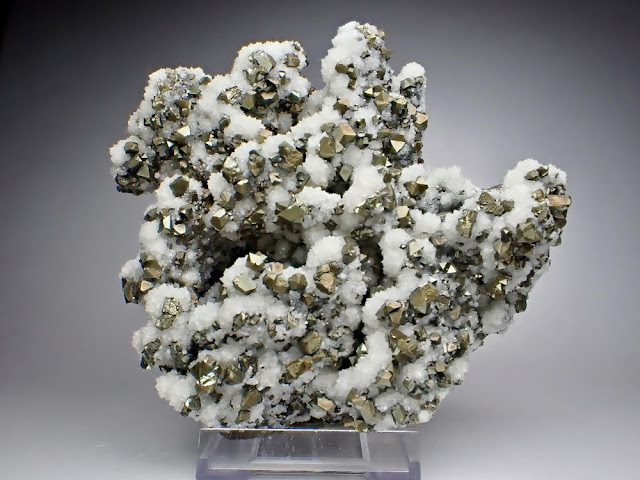黄銅鉱のスピネル式双晶 Chalcopyrite Spinel-law Twins
標本幅 width 13 cm / 重さ weight 775 g
塊状の黄銅鉱をベースにして、無数の細かい石英が立体的に結晶し、その上に径 8 mm までの黄銅鉱のシャープな8面体結晶が散らばる。黄銅鉱が正方晶(2a : c = 1 : 0.985)であることにくわえて、8個すべての面が等大に発達しているわけではないので、ややいびつな多面体になってはいるが、まさに教科書どおりの結晶面だ。特筆すべきは2つの8面体がくっついてスピネル式の双晶をなすものが多数存在するところである。
Octahedral crystals of chalcopyrite to 8 mm in size are sprinkled over a sculptural fine quartz cluster that sits on a base of massive chalcopyrite. Remarkably there are spinel-law twins of chalcopyrite.
The color is whiter than usual ones.
Massive chalcopyrite in the backside.
From Goldschmidt's Atlas der Krystallformen. Crystals like Figs.58 and 59 exist.
以下私見になるが、一般に自形の黄銅鉱は結晶面が湾曲していたり、複雑な連晶をなしていたりして、教科書どおりの単純な形になることが稀である。黄銅鉱のスピネル双晶なんてわたしは初めて見た。ティクリオ鉱山の鉱床がどのようなタイプのものなのかよくわからないが、この標本を見るかぎり、まずメインの黄銅鉱がドサッと固化し、その後微細な石英が、そして少量の黄銅鉱が順次晶出したものと考えられる。シャープな8面体を呈するのはこの最終段階の黄銅鉱である。
これと似たプロセスを経たと思われるのが、秋田県の荒川鉱山などで産出する三角式または三角針式黄銅鉱である。たとえば砂川一郎(所謂三角式黄銅鉱に就いて、地調月報 2巻 6号、1951)が記述した青森県弘前市の舟打鉱山の例では、まずメインの硫化金属が晶出したあと、それを白色半透明の微細な石英の集合が「雪をかぶった松の枝のよう」に被覆し、それと同時に、またはやや遅れて三角式黄銅鉱が晶出する。三角針式はさらに遅れて最後に結晶する。ペルーと日本でみられるこれら「独特の」黄銅鉱には、鉱化プロセスの最終段階で石英とともに晶出する、という共通性があり、なにか結晶学的な意味があるように思われる。
Chalcopyrite tends to be irregular in shape, having a curved surface or exhibiting complex twining. I saw the chalcopyrite spinel-law twin for the first time. This Peruvian specimen implies that the main chalcopyrite first solidifies and the fine quartz and the remaining chalcopyrite follow. It is this final chalcopyrite that becomes a well-formed octahedral crystal.
Japanese triangular chalcopyrite is considered to be created in a similar condition. Ichiro Sunagawa reported that in Funauchi mine, Aomori prefecture, triangular chalcopyrite crystalized with minute quartz that was like snow on a pine tree in the final stage of ore formation after the main deposition of metal sulfides. Triangular needle chalcopyrite was the last production (see Sunagawa, On the so-called triangular chalcopyrite, Bulletin of GSJ, vol.2 no.6, 1951). The fact that both Peruvian and Japanese "peculiar" chalcopyrite solidify with quartz in the final deposition stage implies some mechanism to create a well-formed chalcopyrite single crystal.
追記
- 「日本鉱物誌・上巻」(伊藤貞市、桜井欽一、中文館書店、1947)によれば、愛媛県別子鉱山の鉱体の割れ目に出る黄銅鉱(いわゆる「吹き寄せ」)の結晶はスピネル式の双晶をしめすという。青森県安部城鉱山産のものにもみられたとある。




